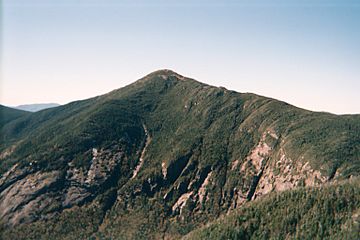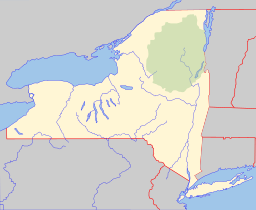Mount Marcy facts for kids
Quick facts for kids Mount Marcy |
|
|---|---|

Mount Marcy (photo taken from Mount Haystack, looking across Panther Gorge)
|
|
| Highest point | |
| Elevation | 5,343 ft (1,629 m) |
| Prominence | 4,914 ft (1,498 m) |
| Listing |
|
| Naming | |
| Etymology | Named for William L. Marcy |
| Native name | Error {{native name}}: an IETF language tag as parameter {{{1}}} is required (help) |
| Geography | |
| Parent range | Adirondack Mountains |
| Topo map | USGS Mount Marcy |
| Climbing | |
| First ascent | August 8, 1837 by Ebenezer Emmons and party |
| Easiest route | Hike (Van Hoevenberg trail) |
Mount Marcy (Mohawk: Tewawe’éstha) is the highest point in New York, with an elevation of 5,344 feet (1,629 m). It is located in the Town of Keene in Essex County. The mountain is in the heart of the Adirondack High Peaks region of the High Peaks Wilderness Area. Its stature and expansive views make it a popular destination for hikers, who crowd its summit in the summer months.
Lake Tear of the Clouds, at the col between Mounts Marcy and Skylight is often cited as the highest source of the Hudson River, via Feldspar Brook and the Opalescent River, even though the main stem of the Opalescent River has as its source a higher point two miles north of Lake of the Clouds, and that stem is a mile longer than Feldspar Brook.
History
Prior to White settlement of the area, the mountain was known as Tewawe'éstha ("it pierces") in Mohawk and Tahawus ("cloud-splitter") in Algonquin.
The mountain is named after Gov. William L. Marcy, the 19th-century Governor of New York, who authorized the environmental survey that explored the area. Its first recorded ascent was on August 5, 1837, by a large party led by Ebenezer Emmons looking for the source of the East Fork of the Hudson River. Today the summit may be reached by multiple trails. Though a long hike by any route, a round-trip can be made in a day.
Vice President (and former governor) Theodore Roosevelt was at his hunting camp, Tahawus, on September 14, 1901, after summiting Marcy, when he was informed that President William McKinley, who had been shot a week earlier, had taken a serious turn for the worse.
Roosevelt and his party hiked ten miles (16 km) down the southwest face of the mountain to Newcomb, New York where he hired a stage coach to take him to the closest train station at North Creek. At some point along the route, Roosevelt learned that McKinley had died, and so Roosevelt took the train to Buffalo to be sworn in as the President. The route from Newcomb to North Creek has been designated as the Roosevelt-Marcy Trail.
Routes
Mount Marcy is the tallest of the High Peaks of the Adirondack Mountains. The majority of the mountain is forested, although the final few hundred feet is above the tree line. The peak is dominated by rocky outcrops, lichens, and alpine shrubs. There are two plaques at the top commemorating the centennial of the first dated climb as well as the mountain summit itself.
The shortest and most frequently used route up the mountain is from the northwest, the Van Hoevenberg Trail, which starts at the Adirondak Loj near Heart Lake. From there it is 7.4 miles (11.2 km) to the summit, a lengthy 14.8-mile (22.4 km) roundtrip which can nevertheless be done in a day. A large section of the trail is suitable for alpine skiing and snowboarding.
The summit via the Johns Brook Trail from the Garden parking north of the mountain in Keene Valley is an 18-mile (28.8 km) round trip, which may be broken at Johns Brook Lodge.
A lengthier southern approach can be made from either of the two major trailheads for the southern High Peaks, Upper Works or Elk Lake.
Visibility on the summit occasionally affords very distant views of most of the Monteregian Hills volcano chain in Quebec's St Lawrence valley as far north as Mont St Hillaire. Views of Burlington and Lake Champlain adorn the surrounding Green Mountains with visibility extending far beyond the Southern Adirondacks as well.
Climate
According to the Köppen climate classification system, Mount Marcy has a Warm-summer, Humid continental climate (Dfb). Dfb climates are characterized by a least one month having an average mean temperature ≤ 32.0 °F (0.0 °C), at least four months with an average mean temperature ≥ 50.0 °F (10.0 °C), all months with an average mean temperature < 71.6 °F (22.0 °C) and no significant precipitation difference between seasons. Although most summer days are comfortably humid on Mount Marcy, episodes of warmth and moderate humidity can occur with heat index values > 79 °F (26 °C). Since 1981 at Mount Marcy (elevation 5,344 ft (1,629 m)), the highest air temperature was 85.7 °F (29.8 °C) on 08/03/1988, and the highest daily average mean dew point was 67.6 °F (19.8 °C) on 08/01/2006. Since 1981, the wettest calendar day was 4.95 inches (126 mm) on 09/16/1999. During the winter months, the average annual extreme minimum air temperature on Mount Marcy (elevation 5,344 ft (1,629 m)) is −32.4 °F (−35.8 °C). Since 1981, the coldest air temperature was −36.0 °F (−37.8 °C) on 01/27/1994. Episodes of extreme cold and wind can occur with wind chill values < −49 °F (−45 °C). The average annual snowfall total (Sep-May) is ≈ 200 inches (508 cm).
| Climate data for Mount Marcy, 1981-2010 normals (elevation 4,537 ft (1,383 m)), 1981-2018 extremes (elevation 3,825 ft (1,166 m)) | |||||||||||||
|---|---|---|---|---|---|---|---|---|---|---|---|---|---|
| Month | Jan | Feb | Mar | Apr | May | Jun | Jul | Aug | Sep | Oct | Nov | Dec | Year |
| Record high °F (°C) | 54.3 (12.4) |
55.0 (12.8) |
70.5 (21.4) |
80.8 (27.1) |
82.8 (28.2) |
84.2 (29.0) |
85.4 (29.7) |
85.7 (29.8) |
84.6 (29.2) |
74.6 (23.7) |
62.9 (17.2) |
57.1 (13.9) |
85.7 (29.8) |
| Mean daily maximum °F (°C) | 17.0 (−8.3) |
20.0 (−6.7) |
29.6 (−1.3) |
44.6 (7.0) |
56.2 (13.4) |
64.7 (18.2) |
68.4 (20.2) |
67.3 (19.6) |
60.8 (16.0) |
49.3 (9.6) |
34.1 (1.2) |
21.8 (−5.7) |
44.6 (7.0) |
| Daily mean °F (°C) | 9.2 (−12.7) |
12.3 (−10.9) |
20.5 (−6.4) |
34.0 (1.1) |
46.0 (7.8) |
54.7 (12.6) |
58.9 (14.9) |
57.8 (14.3) |
51.2 (10.7) |
39.5 (4.2) |
26.7 (−2.9) |
14.8 (−9.6) |
35.6 (2.0) |
| Mean daily minimum °F (°C) | 1.4 (−17.0) |
4.5 (−15.3) |
11.5 (−11.4) |
23.4 (−4.8) |
35.8 (2.1) |
44.7 (7.1) |
49.4 (9.7) |
48.3 (9.1) |
41.6 (5.3) |
29.6 (−1.3) |
19.3 (−7.1) |
7.9 (−13.4) |
26.6 (−3.0) |
| Record low °F (°C) | −36.0 (−37.8) |
−32.0 (−35.6) |
−28.7 (−33.7) |
−3.5 (−19.7) |
19.0 (−7.2) |
22.4 (−5.3) |
31.9 (−0.1) |
29.6 (−1.3) |
20.3 (−6.5) |
10.5 (−11.9) |
−14.4 (−25.8) |
−29.7 (−34.3) |
−36.0 (−37.8) |
| Average precipitation inches (mm) | 4.76 (121) |
3.91 (99) |
4.87 (124) |
5.50 (140) |
6.41 (163) |
6.39 (162) |
6.91 (176) |
6.97 (177) |
6.76 (172) |
6.96 (177) |
6.43 (163) |
5.34 (136) |
71.21 (1,809) |
| Average relative humidity (%) | 85.8 | 81.8 | 69.5 | 61.6 | 65.5 | 74.3 | 77.8 | 78.6 | 79.9 | 74.0 | 78.5 | 88.0 | 76.3 |
| Average dew point °F (°C) | 5.8 (−14.6) |
7.8 (−13.4) |
12.1 (−11.1) |
22.2 (−5.4) |
35.1 (1.7) |
46.7 (8.2) |
52.0 (11.1) |
51.2 (10.7) |
45.2 (7.3) |
31.9 (−0.1) |
20.9 (−6.2) |
11.9 (−11.2) |
28.7 (−1.8) |
| Source: PRISM | |||||||||||||
Ecology
According to the A. W. Kuchler U.S. potential natural vegetation types, Mount Marcy would have a dominant vegetation type of Northeastern Spruce/Fir (96) with a dominant vegetation form of Northern Conifer Forest (22). The plant hardiness zone on Mount Marcy (elevation 5,344 ft (1,629 m)) is 3b with an average annual extreme minimum air temperature of −32.4 °F (−35.8 °C). The spring bloom typically peaks around May 30 and fall color usually peaks around September 19.
Gallery
Images for kids








